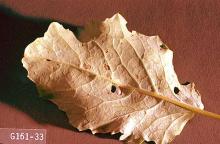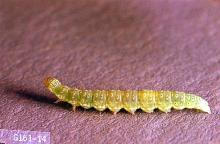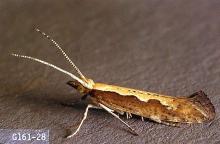Plutella xylostella
Pest description, crop damage, biology and life history
See:
Common Pests of Vegetable Crops
Pest monitoring Natural enemies and insecticides applied to control other pests keep the diamondback moth under satisfactory control in most fields, but keep records of diamondback moths as you monitor for other caterpillars. Adult moths frequently migrate from fields being harvested or disked under.
Management-biological control
Natural enemies, including an ichneumid wasp and the egg parasite Trichogramma pretiosum, often effectively control diamondback moth in California. Therefore, take into account the level of parasitism when making control decisions. Clearly, Bt is much easier on the beneficial insects, and its use, when needed, helps conserve the beneficial insect complex.
Management-chemical control: HOME USE
- azadirachtin (neem oil)-Some formulations are OMRI-listed for organic use.
- Bacillus thuringiensis var. kurstaki (Btk)-Some formulations are OMRI-listed for organic use.
- bifenthrin
- carbaryl
- cyfluthrin
- deltamethrin
- esfenvalerate
- insecticidal soap (as a mix with spinosad)-May require several applications. Some formulations are OMRI-listed for organic use.
- permethrin
- pyrethrins-Some formulations are OMRI-listed for organic use.
- spinosad-Some formulations are OMRI-listed for organic use.
- zeta-cypermethrin
Management-chemical control: COMMERCIAL USE
- Bacillus thuringiensis (Javelin) at 0.12 to 1.5 lb/A. PHI 0 days. REI 4 hr. Acts slowly; may need multiple applications. Add an appropriate spreader-sticker to enhance control. Most effective on small larvae. Some formulations are OMRI-listed for organic use.
- bifenthrin (Brigade WSB) at 0.08 to 0.1 lb ai/A. PHI 21 days. REI 12 hr. Do not exceed 0.5 lb ai/A per season. Retreatment interval 7 days.
- carbaryl (Sevin 4F) at 1 to 2 lb ai/A. PHI 7 days. REI 12 hr. Washington and Oregon only.
- zeta-cypermethrin (Mustang) at 0.05 lb ai/A. PHI 7 days. REI 12 hr. Retreatment interval 7 days. Do not exceed 0.3 lb ai/A per year
These products contain commonly used active ingredients for control of diamondback moth in radish. There are other materials available. Please consult a licensed crop advisor for additional recommendations.



